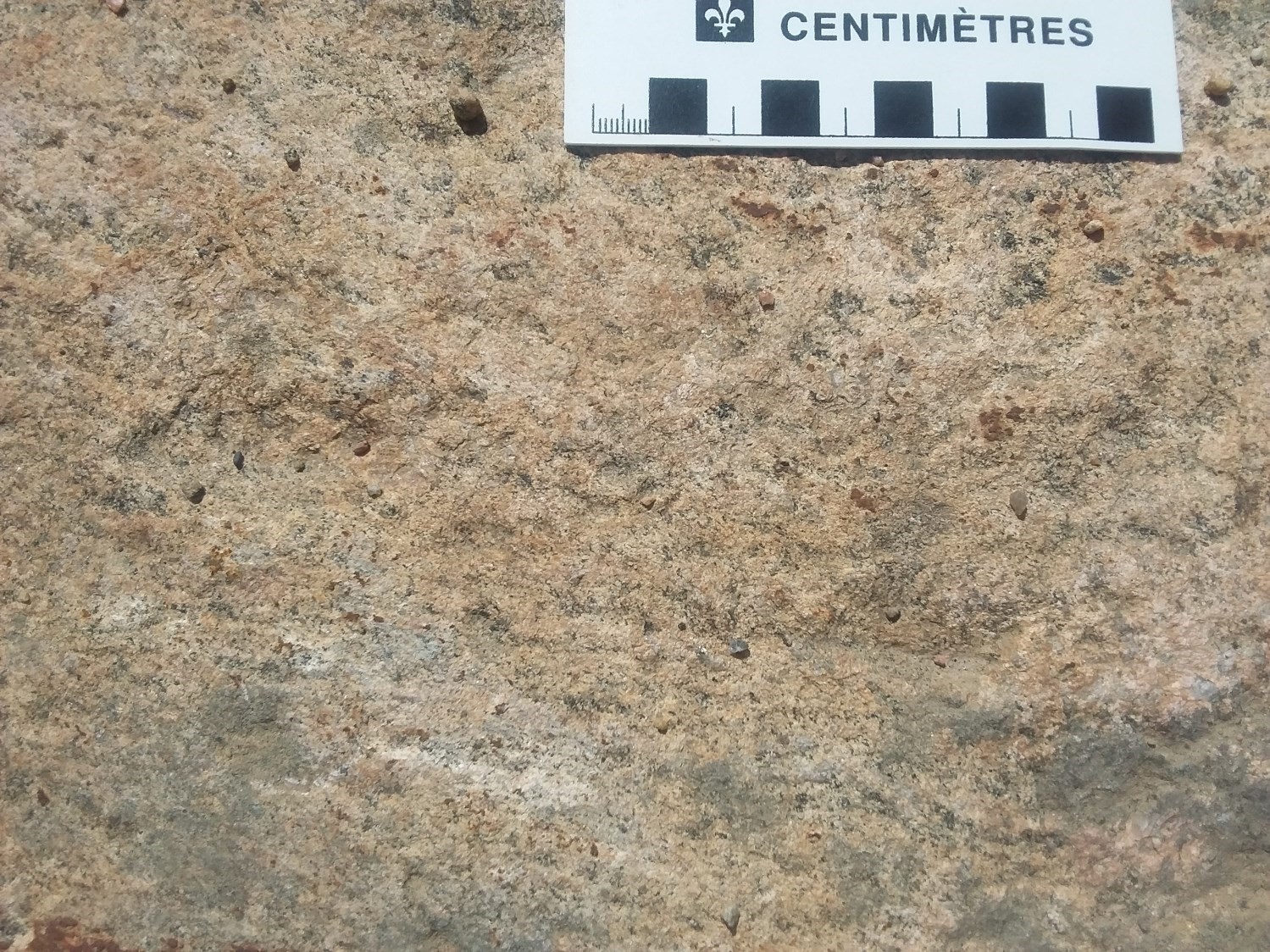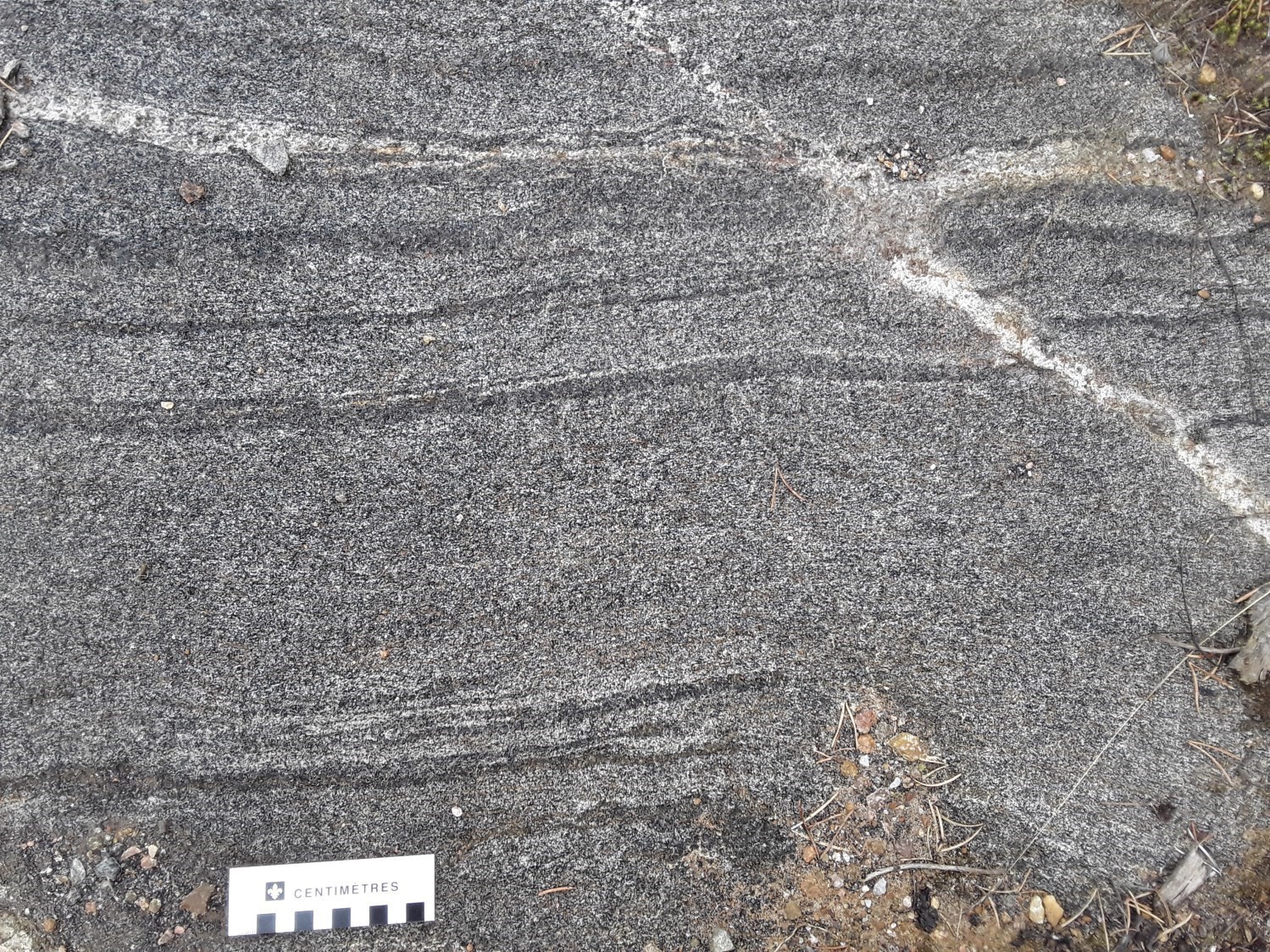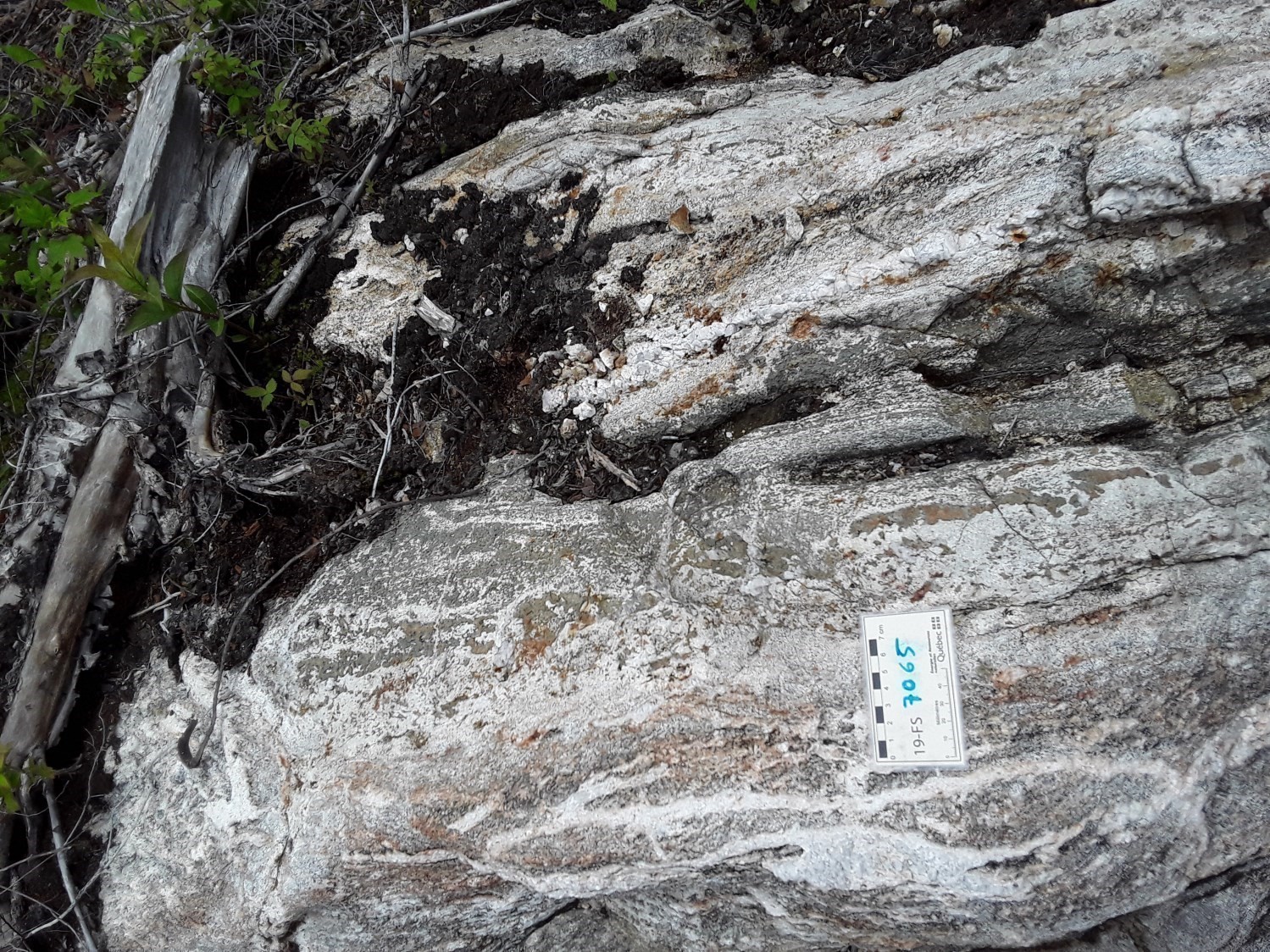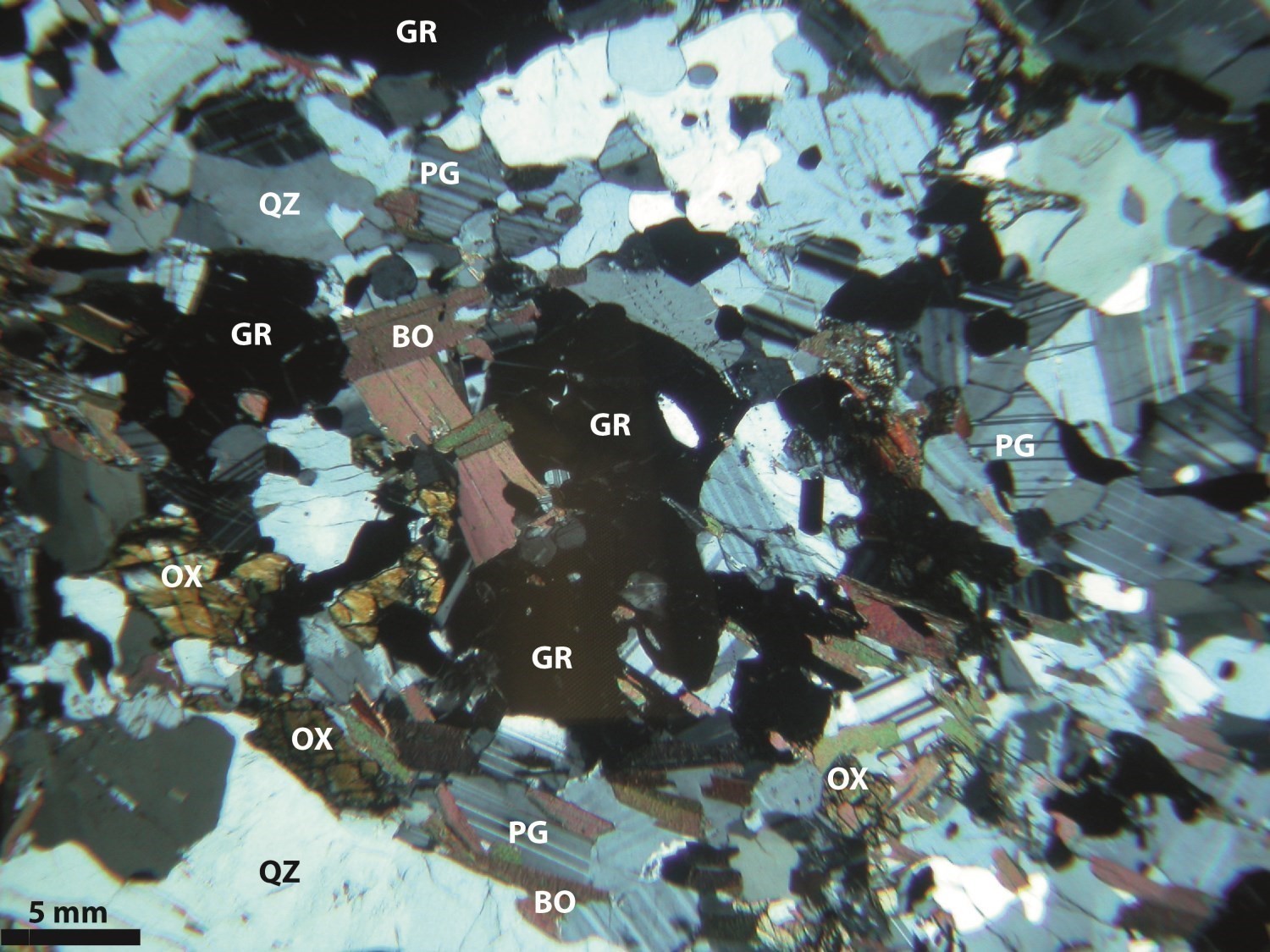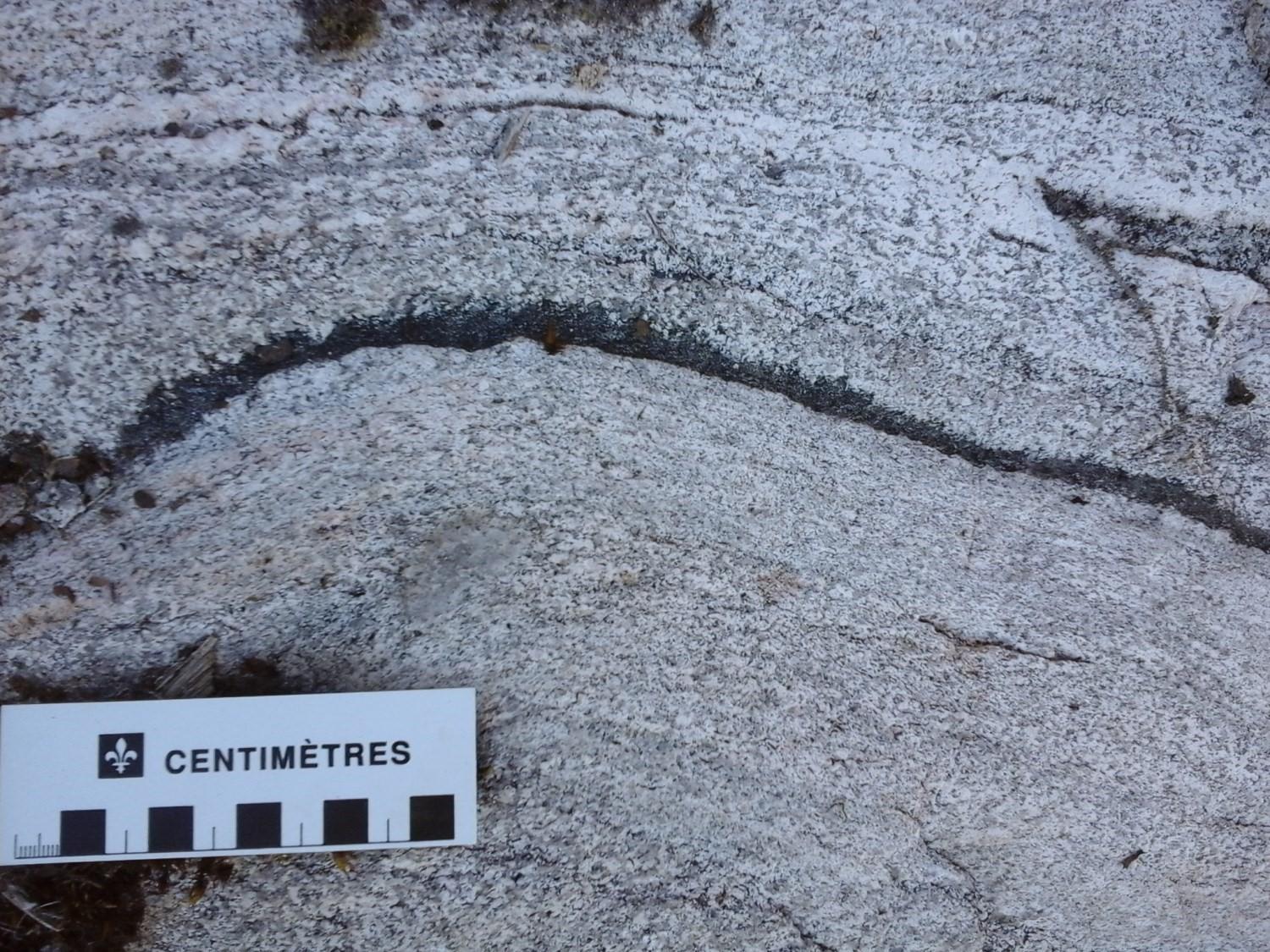
DISCLAIMER: This English version is translated from the original French. In case of any discrepancy, the French version shall prevail.
| Author: | Morfin et al., 2015 |
| Age: | Mesoproterozoic |
| Stratotype: | None |
| Type area: | NTS sheets 32A10 and 32A07 |
| Geological province: | Grenville Province |
| Geological subdivision: | Allochton |
| Lithology: | Orthogneiss, paragneiss |
| Category: | Lithostratigraphic |
| Rank: | Complex |
| Status: | Formal |
| Use: | Active |
None
Background
The Barrois Complex was introduced by Morfin et al. (2015) during the geological survey of the Chambord, Roberval and Notre-Dame-de-la-Doré area (sheets 32A08, 32A09 and 32A10). The same authors also identified the complex in sheets 32A06 and 32A11 during a geological survey. Moukhsil and Daoudene (2019) and Moukhsil and El Bourki (2020) recognized the complex in the Commissaires Lake (sheets 32A01, 32A02, 32A07 and 32A08) and Normandin (sheets 32A15 and 32A16) areas, respectively.
Description
Barrois Complex 1 (mPboi1): Granodioritic to Tonalitic Orthogneiss; Granitic Gneiss
Unit mPboi1 consists mainly of orthogneiss. These are very heterogeneous and closely related to paragneiss layers (mPboi4). Generally, these orthogneiss are whitish grey, fine to medium grained and more or less banded. Their composition is highly variable, but it is usually granodioritic to tonalitic and, more locally, monzogranitic. Ferromagnesian minerals (biotite, brown hornblende) can make up 15 to 25% of the rock.
Gneiss is greyish to pinkish and medium grained. It is granitic in composition with K-feldspar, plagioclase, amphibole and biotite. Orthopyroxene is generally replaced by amphibole or biotite along grain edges, giving the rock a coronitic texture. Gneissosity is mainly marked by the elongation of discontinuous clusters of ferromagnesian minerals that delineate quartzofeldspathic bands whose grains themselves show a slight preferential flattening perpendicular to foliation.
Barrois Complex 2 (mPboi2): Orthopyroxene Orthogneiss, Charnockite, Enderbite
Unit mPboi2 was only observed in sheet 32A10, mainly in its western portion (Morfin et al., 2015). It consists of orthopyroxene gneissic rocks (charnockite, enderbite), medium-grained and granoblastic. Orthopyroxene is observed in the field and in thin section. It is millimetric and contained in a fine-grained foliated quartzo-feldspathic matrix.
Barrois Complex 3 (mPboi3): Orthogneiss with Amphibolite Boudins
Unit mPboi3 consists of orthogneiss similar to unit mPboi1, but contains decimetric layers of medium-grained, more or less boudinaged and migmatized gneissic amphibolite. Dark green to black amphibolite layers are composed of plagioclase, hornblende and locally clinopyroxene. These layers are commonly magnetic, generally homogeneous and fine grained. Pyroxene is present in minor amounts (<1%). Amphibolite locally contains medium-grained leucocratic clusters interpreted as leucosome when associated with ferromagnesian clusters. Migmatitic layers, usually stromatic, are whitish, coarse grained and derived from granodioritic to granitic rocks.
Barrois Complex 4 (mPboi4): Paragneiss
Unit mPboi4 consists of paragneiss within orthogneiss of the complex’s other units (mPboi1 to mPboi3). Paragneiss is banded and is generally differentiated from orthogneiss by a greater proportion of biotite, making it more mesocratic. Garnet and sillimanite are locally present. Garnet occurs as lilac-pink porphyroblasts that can grow to centimetric size. Sillimanite is fibrous and can represent up to 10% of the rock. It is locally associated with graphite (1-2%). Paragneiss is migmatitic, and the whitish to pinkish mobilisate is granitic. Contact between paragneiss and orthogneiss is not observed.
Morfin et al. (2015) identified two informal subunits (mPboi4a and mPboi4b). In the Commissaires Lake area (sheets 32A01, 32A02, 32A07 and 32A08), Moukhsil and Daoudene (2019) did not represent them on their 1:50 000 scale maps due to their small size. Moukhsil and El Bourki (2020) identified them in the Normandin area (sheet 32A15) and added a third subunit (mPboi4c).
Barrois Complex 4a (mPboi4a): Rusty Garnet-Sulphides-Graphite Paragneiss, Migmatitic Paragneiss, Migmatite, Granitic Gneiss
This paragneiss is rusty in altered patina and contains up to 2% sillimanite, 5% pyrite and 2-3% graphite flakes a few millimetres thick. The rock is migmatitic and bedded (alternating dark and light beds) because of partial melting it has undergone. Dark beds (restite, melanosome or both) are millimetre thick and rich in biotite, locally in garnet and sillimanite. Light beds (mobilisate, leucosome or both) are centimetre to metre thick and rich in quartz and K-feldspar, and contain minor amounts of biotite and orthopyroxene. Where partial melting is more significant, the rock is more likely to be a whitish migmatite containing biotite paragneiss boudins and rafts. In the Normandin area, paragneiss layers are difficult to recognize at the edge of this subunit. These are cut by coarse-grained to pegmatitic pinkish granite dykes and veins, giving the rock an appearance of granitic gneiss.
Barrois Complex 4b (mPboi4b): Paragneiss with Quartzite Interbeds
Unit mPboi4b paragneiss contains quartzite layers a few decimetres to several metres thick. The rock is locally migmatitic and contains biotite, garnet, pyrite and magnetite. Quartzite interbeds are locally rusty, centimetre thick and contain a few graphite flakes and ~1% pyrite-pyrrhotite.
Barrois Complex 4c (mPboi4c): Biotite-Sillimanite-Garnet-Graphite Paragneiss, Amphibolitized Mafic Volcanics, Marble, Calcosilicate Rocks, Garnetite and Graphite-Garnet Quartzite
Unit mPboi4c outcrops mainly in sheet 32A15, where it makes up >50% of the Barrois Complex. Paragneiss is generally rusty and composed of millimetric biotite flakes (~40%), sillimanite (1-5%), graphite (<2%), garnet (<5%) and <1% sulphides (pyrite, chalcopyrite and pyrrhotite) associated with iron oxides (magnetite, ilmenite and goethite). Locally, in graphite-enriched zones, Mg, Fe and Zn-bearing chlorite (1-2%) and traces of millimetric sphalerite are observed on contact with pyrite and magnetite. Rusty paragneiss also contains magnesian biotite (phlogopite), fluoroapatite, monazite and large carbonate clusters.
Fine-grained mafic rocks associated with biotite paragneiss and quartzite layers were interpreted as amphibolitized volcanics. These rocks are commonly heterogeneous and contain hornblende, garnet porphyroblasts (up to 2 cm in diameter), clinopyroxene, orthopyroxene and biotite. These mafic lithologies are also distinguished by their very faint magnetic signatures compared to other gabbro or gabbronorite units present in the area.
Marble occurs as layers in biotite paragneiss. The rock is calcitic to dolomitic, medium to coarse grained and whitish to greyish in fresh exposure. The mineralogical composition is: calcite (60-80%), dolomite (<10%), diopside (<2%), biotite (<1%), quartz with undulatory extinction (3-4%), scapolite (<1%), graphite (<1%) and trace minerals such as apatite, actinolite and pyrite. Minor amounts of rusty graphite-garnet paragneiss, boudinaged calcosilicate rocks, and centimetric to metric layers of impure quartzite are associated with this marble.
Calcosilicate rocks form centimetric to metric greenish layers, medium-grained, rich in clinopyroxene associated with garnet (2%).
Garnetite is rusty to reddish and occurs as centimetric layers in biotite paragneiss. It is medium to coarse grained and contains 30-45% garnet porphyroblasts, 6% quartz, 15% biotite, 5% plagioclase, 10% chlorite, 1-2% clinopyroxene, 5-8% sillimanite sheaves, 5% graphite disseminated in millimetric flakes (1-5 mm), <1% ilmenite, 1% staurolite with quartz inclusions, 1% sulphide (pyrite, pyrrhotite, pentlandite, and chalcopyrite with traces of micrometric sphalerite) and 1% zircon. Garnet porphyroblasts are millimetric to centimetric and contain quartz and plagioclase inclusions; locally, they are associated with small millimetric orthopyroxene crystals.
Quartzite is whitish grey in fresh exposure and rusty in altered patina. Beds are fine to medium grained, 1.5 to 2 m thick and contain 2-3% K-feldspar and plagioclase, 5-8% biotite, 2% graphite, <1% garnet, 1% disseminated sulphides (pyrite and pyrrhotite) and clinopyroxene traces. Quartzite also occurs as centimetric boudins in migmatitic biotite paragneiss.
Thickness and Distribution
The Barrois Complex outcrops mostly in sheet 32A10 where it occupies more than 50% of the area (Morfin et al., 2015). It also occupies ~20% of sheet 32A07 area, where it forms a large strip oriented NNW-SSE over a distance of several kilometres (Moukhsil and Daoudene, 2019). Moukhsil and El Bourki (2020) also mapped a large volume of this complex in the NW portion of sheet 32A15.
Dating
Dating of two quartzite samples from the Barrois Complex (outcrops 2019-FS-7085 and 2019-AM-002) indicates that the maximum age of deposition is ~1224 Ma, indicating emplacement during the Elzevirian Orogenesis, as proposed by Gower and Krogh (2002; 1230-1180 Ma).
| Unit | ample Number | Isotopic System | Mineral | Maximum deposition age (Ma) | (+) | (-) | Reference(s) |
| mPboi4c | 2019-FS-7085D | U-Pb | Zircon | 1224 | 18 | 18 | Papapavlou, 2020 |
| 2019-AM-002B | U-Pb | Zircon | 1237 | 8 | 8 | Papapavlou, 2020 |
Stratigraphic Relationship(s)
Informal units of the Barrois Complex form metric to decametric enclaves and tectonic slices in several intrusions of the area (Mimosa, Marianne, Bardeau and Léo plutonic suites). Units of the Barrois Complex are also cut by granitic to syenitic pegmatite dykes and the Claire Gabbronorite.
Paleontology
Does not apply.
References
Publications Available Trough Sigéom Examine
MORFIN, S., TREMBLAY, C., SOLGADI, F., MOUKHSIL, A., DAIGNEAULT, R. 2015. GEOLOGIE DE LA REGION DE CHAMBORD, ROBERVAL ET NOTRE-DAME-DE-LA-DORE (FEUILLETS SNRC 32A08, A09 ET A10) ET RECONNAISSANCE DES FEUILLETS 32A06, A07 ET A11. MERN, CERM. MB 2015-07, 69 pages and 5 plans.
MOUKHSIL, A., DAOUDENE, Y. 2019. Geology of Commissaire Lake area, Grenville Province, Saguenay–Lac-Saint-Jean region, Quebec, Canada. MERN. BG 2019-01, 1 plan.
MOUKHSIL, A., EL BOURKI, M. 2020. Geology of Normandin area, Grenville Province, Saguenay–Lac-Saint-Jean region, Quebec, Canada. MERN. BG 2020-01, 1 plan.
PAPAPAVLOU, K. 2020. U-Pb geochronology report; Grenville 2019-2020. UQAM. MB 2020-09, 25 pages.
Other Publications
GOWER, C.F., KROGH, T.E., 2002. A U-Pb geochronological review of the Proterozoic history of the eastern Grenville Province. Canadian Journal of Earth Sciences, volume 39, pages 795-829. doi.org/10.1139/e01-090
Suggested Citation
Ministère de l’Énergie et des Ressources naturelles (MERN). Barrois Complex. Quebec Stratigraphic Lexicon. https://gq.mines.gouv.qc.ca/lexique-stratigraphique/province-de-grenville/complexe-de-barrois_en [accessed on Day Month Year].
Contributors
|
First Publication |
Abdelali Moukhsil, P. Geo., Ph.D. abdelali.moukhsil@mern.gouv.qc.ca; Yannick Daoudene, P. Geo., Ph.D. yannick.daoudene@mern.gouv.qc.ca (redaction) Mehdi A. Guemache, P. Geo., Ph.D. (coordination); Fabien Solgadi, P. Geo., Ph.D. (critical review); Simon Auclair, P. Geo., M.Sc. (editing); Céline Dupuis, P. Geo., Ph.D. (English version); Nathalie Bouchard (HTML editing). |
|
Revision(s) |
Abdelali Moukhsil, géo., Ph. D. abdelali.moukhsil@mern.gouv.qc.ca; Mhamed El Bourki, GIT, M.Sc. mhamed.el-bourki@mern.gouv.qc.ca (redaction) Mehdi A. Guemache, P. Geo., Ph.D. (coordination); Fabien Solgadi, P. Geo., Ph.D. (critical review); Simon Auclair, P. Geo., M.Sc. (editing); Céline Dupuis, P. Geo., Ph.D. (English version); Nathalie Bouchard (HTML editing). |


